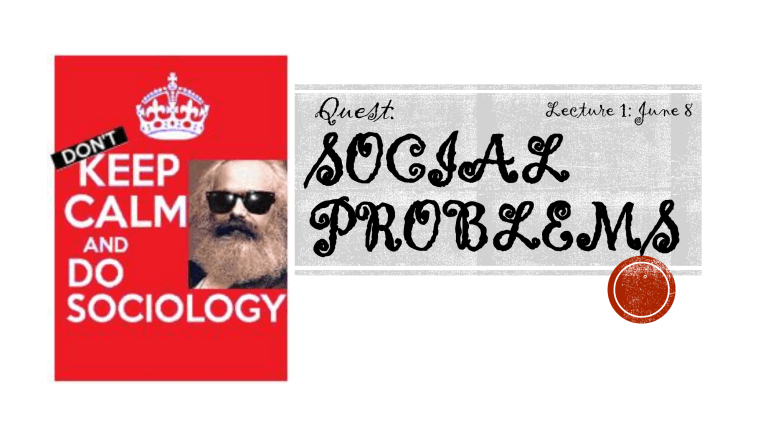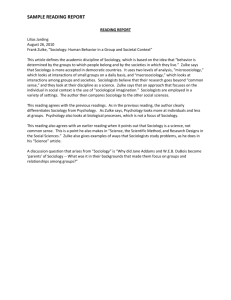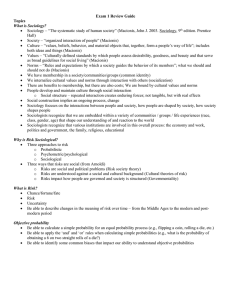File - Social problems

Quest
:
Lecture 1: June 8
SOCIAL
PROBLEMS
Say it with me…
Muh – LEE – zee – uh
…or just “Prof,” “Professor”
Welcome to SYG2010: Social Problems!
Today’s schedule:
Logistics:
Hand out syllabus
Review assignments, grading, policies and schedule
General format of lectures
Introductions
Prof. Malizia’s background, interests and current projects
Sign into study groups, student introductions
Topics
What is a social problem?
How do sociologists view social problems?
Contact info:
Email: smalizia@hccfl.edu
–response w/in 24 hours (except weekends)
Office: Administration building, room 202 (adjunct lounge)
Office hours: Mon-Thurs after class, 3:30-4:30p.m. (or by appt.)
Fill in classroom (2 blanks on syllabus…)
Course description & goals
Assignments and grading (and tracking your own grade…)
Conduct policies
Schedule (topics, assignments, tests)
General format for lectures
My philosophy of teaching
Open, democratic discourse: we all learn from all.
Open to all feedback: teaching/learning/life is a work in progress.
Flexible: help me to help you.
Big picture view: stay engaged & keep in contact with me, and you’ll get a grade you can be happy about!
My credentials
BA in sociology from Eckerd College
MA and PhD in sociology from University of California, Irvine
My teaching experience
Around 15-20 semesters as TA
Instructor ~2 years, 14 courses @ 4 campuses
Currently 3 other courses @ HCC & PHSC
At
…
Studied micro-sociology
Social construction of identities, subcultures, and reality
Tampa Bay punk scene
Rapture of Combat
Lived in St. Pete Beach, nearby
At
…
Studied macro-sociology:
Globalization of environmentalism
Medical marijuana social movement
Lived Venice Beach, near
(And OC, Compton, Hollywood)
Taught @ UCI & @ Cal. State Dominguez Hills
(Deviance, Globalization, Theory, Intro)
Local? Grade? Experience with sociology and/or dual enrollment?
Going to college? University, community college…?
What do you think we’ll study in Social Problems?
What might you like to study in Social Problems?
EXERCISE: form study groups of 5-6ppl., contacts & “ice-breaker” handout
(Participation points for today.)
All lectures will start with a slide like this (right after announcements). Copy these down each class and you’ll have a full study guide by the end of the week!
Vocab:
sociology, society, culture, deviance, social problem, social group, social structure
Concepts:
Sociological imagination, social construction
How have people viewed social problems over time?
Social pathology social disorganization social structure
How do sociologists view social problems?
Functionalism vs. conflict vs. interactionist
What might these look like as test questions?
WHEN YOU:
THEN YOU SAY:
Be more (self-) aware in any situation.
Win the respect of others.
Understand the social forces that help you or hurt you in everyday life.
Realize the links between history, news, foreign affairs, business, politics…and you.
Take control of your life.
Impress friends and relatives.
(Even if you’re just an amateur…)
The scientific study of human society and everything it interacts with.
From global to individual processes.
Claiming ground from psychology, history, economics, political science…
Society is “people who share a territory and many patterns of behavior” (Macionis).
Society is “a group of people who interact and share a common culture, as a means to survive and find meaning in life” (Malizia).
Anything made/invented by humans.
Material things like clothing, books, art, food, calculators, paper…
Ideal concepts like norms, values, identities, worldviews.
“Conditions that undermine the well-being of some or all members of a society and is usually a matter of public controversy” (Macionis).
“A situation the public believes is harming some or all citizens, which they believe demands a societal response” (Malizia).
Opposite is a personal problem.
Implies a need for authorities to act, not just individual people involved.
Some blurry cases…
Examples of personal vs. social problems?
Term coined by Mills to mean understanding your place in society and history, realizing social forces are influencing your life (for the worse), redefining personal problems as public, social ones.
Classic example: Durkheim’s Suicide.
Ostensibly a personal decision…
But follows trends: historical, group identity…
Proof of social forces at play, not just individual choices.
Where do the causes and solutions of social problems lie?
1.
Earlier societies didn’t take such a protective role of citizens.
Social problems are criminals and invading armies.
Otherwise, life is simple, deal with it yourself!
2.
With the industrial revolution (starting late 1700s) societies start changing rapidly…
Many new social problems arise as citizens are pushed into new lifestyles and new immigrants cause culture clash.
Authorities now have the duty of “adjusting” groups of people to new changes.
3.
With the industrial revolution in full swing (early 1800s), the discipline of sociology is founded…
Intellectuals discover social problems not caused by maladjusted groups, but by the rules of society itself.
Authorities now have the duty of “updating” societal rules when problems are found.
First of those three periods from last slide.
Social organization is very simple under feudal systems:
Most people farm, some craftsmen, handful of nobles and clergy.
Not much social life! Fewer other people to compare yourself to.
Life is tough, but people have gotten used to it over many generations, develop cultural beliefs that their hardships are reasonable and/or deserved.
Only social problem that jumps out & demand authorities’ attention is crime.
Everything else is your own problem. Deal with it or admit to your own deficiency.
The
SOCIAL PATHOLOGY
view of social problems.
AKA the “nuts, sluts, and perverts” view.
Society in general is believed to be fair and functional.
Problems only come from defective, sociopathic individuals.
Only solution: lock ‘em up! (Or execute them.)
Next period, starting in late 1700s as new technology changes lifestyles…
From farm-work to factory-work.
Migration from rural life to urban life.
Immigration from abroad.
Social life is not so simple! Authorities realize people need help adjusting to new environments.
New social problems on the radar like overcrowding, disease, much more crime, pollution, dangerous workplaces, poverty, homelessness…
The
SOCIAL DISORGANIZATION
view of social probs.
Society is still fair and functional.
Groups of people are just too slow to adjust to new ways, dragging society down.
Problem lies with groups of naïve people.
Solution is to assimilate these groups, teach them how to fit into society.
Final period, from early 1800s to current day.
Society still undergoing same changes as previous
(factory work, urban life).
BUT the discipline of sociology is founded!
A new breed of intellectuals looks at the same social problems as previous (poverty, public health, etc.) and more (class inequality, discrimination…); and in greater detail.
Social life is now constantly changing! Authorities listen to sociologists (sometimes) and admit that sometimes people don’t need to fit themselves into society; rather, society needs to adjust to accommodate the people.
The
Social Structure
view of social problems.
Society now is NOT always fair or functional (and maybe it never was?).
Groups are already assimilated, but problems still remain, so…
Problem is with the rules and traditions of society.
Solution is to change the rules (aka “social change”).
What does it mean exactly to say the problem is in a
social structure?
Structures include things like politics, criminal justice system, the law, the church, the education system, the family…
What do all of these have in common?
Structures are sets of rules, traditions, expectations that shape how people think and act.
Doesn’t culture do this too?
Totally! Structure can be thought of as ideal culture that is made more permanent, either by formal documents or by extremely widespread familiarity.
Culture just lives in a few people’s heads and so can be easily changed or forgotten.
Structure lives on paper and/or in most everyone’s heads, hard to change. Structure never dies.
Movie script analogy?
But wait! It gets trickier. Sociologists agree that social problems and solutions are typically structural. But they disagree as to why some structures cause problems.
3 sociological/structural views set up in the earliest days of sociology. In general:
1.
All the structures in society are usually fair, and problems will always reach a solution.
2.
3.
All the structures in society are always unfair, and problems will never disappear.
Structures can be both, and their emergence and solution and unpredictable because society has escaped human control.
We can assume that all societies basically work well for most people. Why?
Society is like a human body. Structures are the organs. People are the cells.
Structures coordinate different tasks necessary for the body to survive.
Environmental changes can throw society out of whack (just as ecosystem changes can threaten an organism). Social problems will result for a little while, until structures evolve to handle the new challenge.
Close look at history reveals that all human societies are essentially a war between a powerful elite and the powerless masses…
Society is like the scene at the end of The Wizard of Oz: one powerful guy behind a curtain uses illusions to distract and control everyone else.
Problems will always exist because elites create them on purpose. They burden the masses so that they cannot succeed and move up to elite status. And they divide people who are tricked into thinking some other social group is the enemy, rather than elites. Any win is temporary; conflict is forever (until we have a communist revolution, anyway).
Close look at actual people reveals that individuals shape structures at the beginning, but they soon grow out of control.
Society is like Frankenstein’s monster: built to satisfy it’s creator, but then breaking loose and terrorizing everyone.
Where and when problems arise and disappear is just too unpredictable. You never know how different structures will evolve and interact with each other to create a terrifying super-beast (aka a social problem).
Whatever the source, social problems are social constructions.
This means that people do not just automatically become aware of every significant problem. They must be brought to the public’s attention by some motivated actor like a social movement or an opinion leader (popular reporter, writer, religious leader, politician, etc.).
So which problems are more likely to come to light?
How might media filter out potential problems?
Sometimes, a very persuasive actor can convince the public of a problem that doesn’t really exist!
Other times, a serious problem doesn’t get recognized at all…









